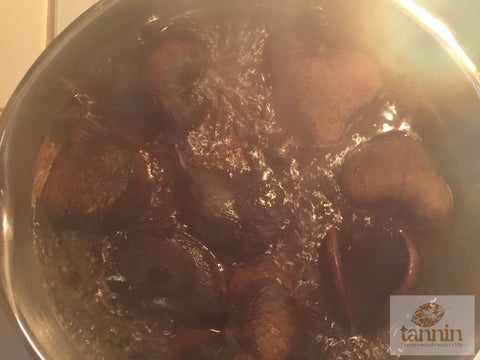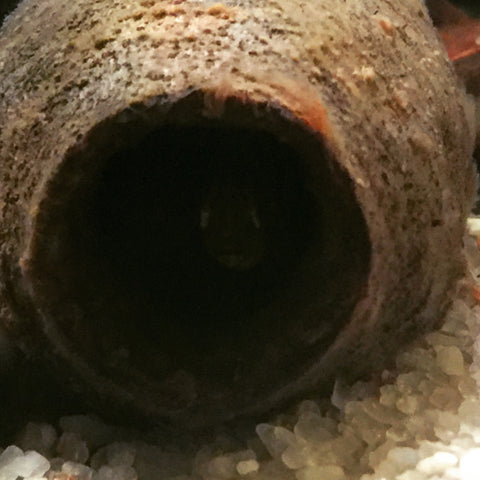- Continue Shopping
- Your Cart is Empty
"Keeping your freak on." Thoughts on the establishment, maintenance and mindset of the "New Botanical"-style aquarium...
We receive more and more questions related to the establishment and long-term maintenance of "New Botanical"-style aquariums, and we are excited, because it's an indication that more and more hobbyists are keen on the idea of establishing and keeping one of these aquariums. Besides, it periodically warrants a review!
When you first establish an aquarium with botanicals, be they leaves, seed pods, or even wood- there is a significant release of not only tannins, but some organics as well. It's important to consider botanicals as not only "aquascaping props", but as materials that can both enrich and tax the aquarium environment, depending upon how they are added.

Huh?
Well, regardless of if you're adding a bunch of botanicals to a new or established aquarium, you need to prepare them in some fashion- whether its by boiling or soaking them for some period of time. Not only will this "crack off" some of the initial burst of tannins, but it will give your botanicals a chance to release some of the dirt and or other organics bound up in their outer layers.

These organics are essentially a bioload for your aquarium, as they will impact the biological filtration.This is why we always admonish our customers to go slowly when adding botanicals to an established aquarium- particularly one with a heavy or delicate fish load.

Massive "dumps" of botanicals into an established aquarium can potentially tax the biological filtration, leaving the existing bacteria population struggling to process a large influx of materials, and could also lead to rapid pH drops or even more sinister stuff, like lower dissolved oxygen levels, etc. Granted, these are unusual, unlikely, and extreme cases- but things like this can happen if you're not careful. You simply don't add a ton of anything all at once to any aquarium. Take the time. It's common sense- and by going slowly and monitoring your basic water chemistry, you will typically avoid most of the potential problems that can result from rapid environmental changes.
Okay, all of the "doom and gloom" warnings aside, what about routine maintenance?
Well, that's pretty straightforward. The real considerations for maintenance in a botanical heavy system are how you want to handle the water tint and any possible biofilms and algae that may appear on your botanicals.
Like in any aquarium, we're huge advocates of regular, frequent water exchanges. I'd obviously leave the amount and frequency to your discretion, but I do recommend that you do them. You may or may not elect to siphon out some botanical debris during these exchanges. The tint of the water can be maintained by regularly replenishing your botanicals (particularly leaves) as they break down and lose their ability to impart tannins into the water. We've gone back and forth numerous times here about the merits of removing leaves as they break down versus leaving them in, so I won't beat that proverbial dead horse yet again!
Suffice it to say that you kind of have to "finesse" things a bit to find what works for you. I have found that a combination of water exchanges (with botanical-infused source water) and periodic replenishment of leaves (not removing the decomposing ones) has worked best for me in maintaining consistent parameters and aesthetics. Other "tinters" regularly remove and replace leaves at the first sign of deterioration, and are fanatical about removing any traces of biofilms, etc. as they appear.
And of course- those biofilms. And the occasional algae. As we've discussed, they are "par for the course" with a botanical-influenced system. Most of us accept this, understand that they are a typically "transitory" phenomenon, and will ebb and flow, or simply pass over time. Some aquariums never experience them, particularly larger water volumes with a lower "botanical-to-tank-capacity ratio", and aquariums where known consumers of the stuff (Shrimp, snails, many species of catfishes, and even some Barbs, Characins, and other fishes that are known to be "grazers") reside.

If you look at almost any of the many underwater videos of The Amazon and other regions by photographers like, Sumer Tiwari, the late Takauhi Amano, and Ivan Mikolji, you'll notice these biofilms and even various algae are almost ubiquitous in most natural environments.

(Sumer Tiwari- in and among the botanicals in India)
The degree to which you'll want to physically remove them- if at all- is purely up to you.
The hardest part, as we've suggested many times, is making that "mental shift" to embrace these natural processes. To understand that these life forms- however distasteful they might be to our aesthetic sensibilities-are normal, and actually contribute to the diversity, stability, and "richness" of the aquatic environment we have created. Coming as we do, from generations of hobbyists accustomed to hating anything like algae and biofilms, let alone, brown water- it's a tough shift to make. I'll give you that. Many aquarium people would just freak out seeing that stuff. I used to, myself. It requires us to break away from what we know and embrace something, although natural in every respect, that aesthetically is completely different.
I virtually guarantee that if you entered a "New Botanical"-style aquarium which had the slightest trace of biofilms into one of those major international aquascaping contests, you'd be absolutely "hammered" by the judges, who would tell that your tank is "poorly maintained", "unstable", poorly executed and thought out, and just plain "sloppy". Essentially, their heads would explode because you didn't enter a sterile, zen-like composition of underwater forests, beaches, "middle earth" scenes, and mountains, which is what has been in "vogue" in the 'scaping world for some time.

Aquascaping aesthetic and our definition of what defines "natural" in this context is being re-defined, expanded..Minds are opening up, if only a few at a time-but they are opening up. And everyone wins as a result.

I love that.
So, rebellious digression aside here, the point of this little piece is that you simply need to employ all of the same types of practices and common sense with a "New Botanical"- style aquarium as you would with any other. The main differences are aesthetics, and embracing and understanding some of the processes and "behaviors" of our botanicals when they are added to our aquariums.

We're still very much at the "ground floor" of what is becoming a more and more "bonafide movement" within the hobby. Everyone's experience and input is valuable at this stage, as we learn together about the nuances- good and bad- of utilizing these amazing natural materials in our aquarium displays.

(Luis Navarro's new tank- the early stages of something special!)
Remember to share. Remember to learn and have fun- the two are not mutually exclusive, as you know.
Stay creative. Stay adventurous. Stay methodical.
And Stay Wet.
Scott Fellman
Tannin Aquatics












Scott Fellman
Author